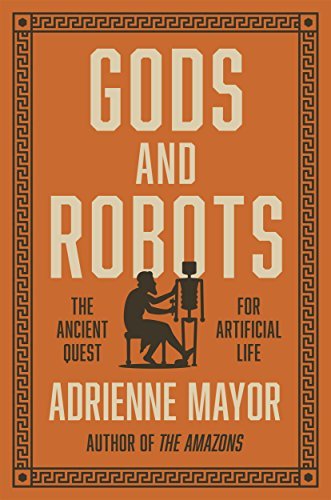What do you think?
Rate this book


407 pages, Kindle Edition
First published November 1, 2018
Hephaestus’s marvels were envisioned by an ancient society not usually considered technologically advanced. Feats of biotechne were dreamed up by a culture that existed millennia before the advent of robots that win complex games, hold conversations, analyze massive mega-data, and infer human desires. But the big questions are as ancient as myth: Whose desires will AI robots reflect? From whom will they learn? [loc. 3576]
Intrigued by the mechanical marvels of The Hymn to Dionysus (which the author has said are based on the writings of Hero of Alexandria) I wanted to learn more about ancient machines. Gods and Robots is perhaps not the ideal book for this, but it was fascinating. Mayor (whose The First Fossil Hunters I found immensely readable) covers mythological and historical stories about immortality, mechanical humanoids, artifical limbs, and Daedalus's self-powered flight to Sicily from Crete. While the focus is on Greek texts, Mayor also mentions Indian, Sumerian and Etruscan myth. And she references modern concepts and culture, including Blade Runner, Karel Čapek, the uncanny valley effect and the current debate about the merits and pitfalls of AI.
The recipes for immortality were interesting (as was Mayor's explanation of the death of Jason's father Aeson by drinking bulls' blood, believed to confer immortality but lethal because of 'the relatively high coagulation factor of ox blood, an effect later affirmed by Aristotle' (loc. 780)) but I was really there for the moving statues and other mechanical marvels of the ancient world. Mayor includes images from vases, carved gems etc which show scenes of techne: Prometheus building a human from the skeleton outwards, or Athene constructing a horse.
Mayor refutes the argument that Bronze Age humans couldn't conceive of automatons because their technology wasn't sufficient to make such things: firstly, one doesn't need to be able to make what one imagines (see under 'fiction') and secondly, the Greeks (and probably other cultures) did make automata, animated statues etc -- though perhaps not as marvellous as the ones they imagines the god Hephaestus making, as mentioned in the Iliad: “Fashioned of gold in the image of maidens, the servants moved quickly, bustling around their master like living women”. She explores accounts of bronze figures that moved and made sounds, and suggests ways in which these might have been made and powered (mercury, steam, water...) and Socrates' argument that such automata should be chained, to prevent them from escaping -- like human slaves.
I also learnt a lot about agalmatophilia 'statue lust': "another infamous case, reported by Athenaeus (second century AD), one Cleisophus of Selymbria locked himself in a temple on the island of Samos and tried to have intercourse with a voluptuous marble statue, reputedly carved by Ctesicles. Discouraged by the frigidity and resistance of the stone, Cleisophus “had sex with a small piece of meat instead” [loc. 1903]. Mayor describes the Pygmalion myth as 'an unsettling description of one of the first female android sex partners in Western history' rather than a romantic love story.
A fascinating read, thoroughly referenced and with plenty of illustrations: very readable.